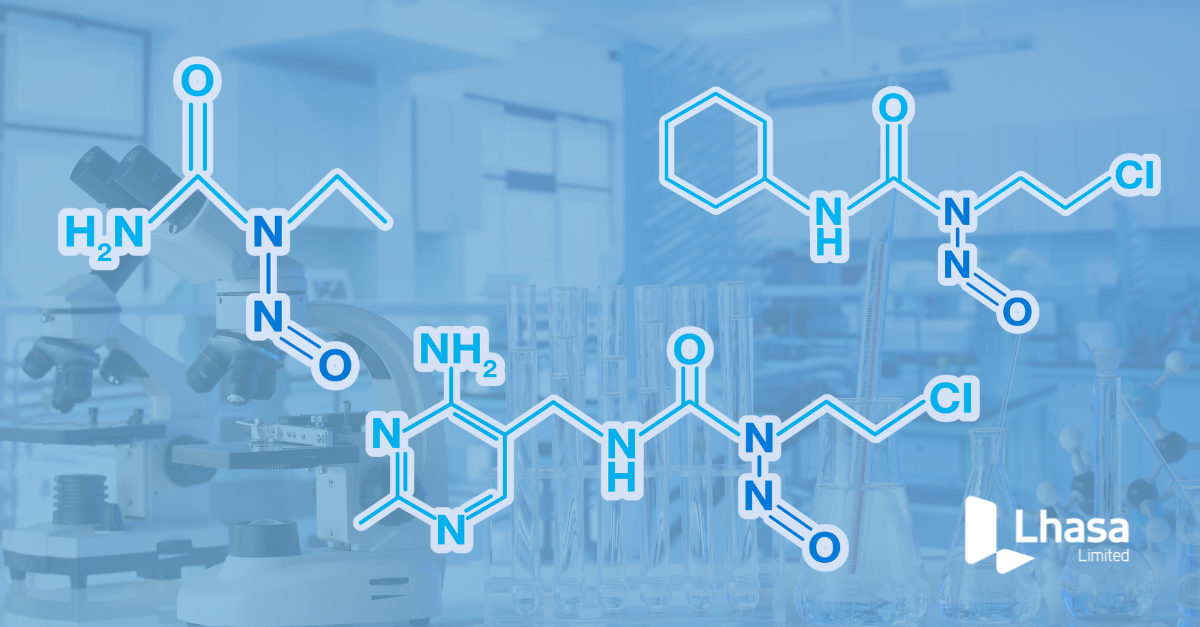The nitrosamine crisis first erupted in July 2018, when the FDA announced voluntary recall of several drugs containing Valsartan: a medicine used to treat high blood pressure and heart failure.
Due to an unreported change in synthesis of Valsartan, the potentially cancer-causing chemical N-nitrosodimethylamine (or NDMA) was detected in the marketed drug product. This resulted in regulators initiating a rapid recall and investigation process of Valsartan. A year later, all Valsartan-containing products were recalled, and acceptable daily intake limits were issued for several N-nitrosamines.
Regulatory agencies such as the EMA & U.S. FDA are now requiring N-nitrosamine risk assessments to be performed on all marketed pharmaceuticals. In this article, we will discuss the 3 key stages of risk assessment and how our tools can be used to support informed decision making on chemical safety:
1. Identifying the source of risk
The first step in a nitrosamine risk assessment is to identify sources of potential risk. This may relate to amine functionality which has been identified within the active substance(s), finished product(s) or formed throughout the manufacturing process. For a risk to be realised, these at-risk structures must be exposed to a nitrosating agent, which may be encountered during manufacturing, or within a final formulation. For the synthetic process itself, Mirabilis – our software tool for accessing carry-over risk for potentially mutagenic impurities in drug substance synthesis – is undergoing redevelopment to better aid carry-over risk assessment. As part of this redevelopment, Mirabilis will utilise information surrounding conditions and structural features present within each reaction stage of the drug synthesis, to identify and highlight reaction stages where nitrosamine forming risk may occur.
Within drug products, nitrites are a common source of nitrosating agent that can be found as impurities in excipients, and therefore the level of risk posed by these impurities needs to be established. In June 2020, a group of pharmaceutical companies came to Lhasa to discuss sharing data on levels of nitrites in common excipients. To date, the Nitrites in Excipients Data Sharing Initiative consists of 24 members and is expanding exponentially, more information on the consortium can be found in this blog piece.
Zeneth, our tool for forced degradation pathways, will soon be able to predict for nitrosating pathways so that nitrosamine-containing degradation products can be identified. This feature will be available within the next release of Zeneth, which is coming soon…
2. Determining the level of activity
Once a nitrosamine impurity has been as identified as a possible (or confirmed) hazard, it is crucial to determine the level of toxicological risk posed, including the potency – if the impurity is carcinogenic. Our in silico toxicity tool, Derek Nexus uses expert derived structural alerts (2D SARs), including alerts for nitrosamine genotoxicity. While many nitrosamines are mutagenic carcinogens, there are small areas of chemical space where observed negative results have allowed their exclusion from Derek Nexus alerts. Where data is conflicting or non-existent, a precautionary approach has been taken and the compounds remain within the scope of the alert. Lhasa have ongoing data-sharing initiatives, and we hope to use the data donated here to investigate the areas where there is little or no data and refine the structure activity relationship (SAR) further, both in Derek Nexus and to publish our results so that this knowledge can be used more widely. Similarly to Derek Nexus, the self-organising hypothesis network in Sarah Nexus has identified hypotheses where compounds are expected to be negative.
The ICH M7 guideline requires the assessment of potentially mutagenic impurities and implements rules for their control. For most compounds, the ‘Threshold of Toxicological Concern’ sets a limit on the acceptable intake, even in cases where no specific carcinogenicity data exists. Nitrosamines, along with a small number of other chemical classes, are in the ‘cohort of concern’ (CoC) due to their extreme carcinogenic potency. Our ICH M7 workflow tool combines the results of Derek Nexus and Sarah Nexus, and provides common expert review arguments to support expert review. Since 2021, a feature has been included within the M7 tool in Nexus which flags when a compound is in the CoC. This allows users to limit the use of mutagens within the CoC that display extremely high carcinogenic potency to lower levels of acceptable intake, as defined in the ICH M7 guidance.
Our ICH M7 expert review arguments have been implemented to specifically discuss subclasses of N-nitroso compounds for which structural features are expected to reduce the mutagenic potential and/or carcinogenic potency. These expert review arguments have been implemented with either a “Positive”, “Negative” or “Inconclusive” overall in silico call, and reflect potential boundaries of the CoC, in cases where, even if mutagenic, the compound is unable to undergo the alpha-hydroxylation mechanism that leads to the extreme carcinogenic potency observed for some nitrosamines.
Including 7,080 in vitro genotoxicity study records for 502 nitrosamines and 1,034 carcinogenicity study records for 262 nitrosamines, Vitic is a structure-searchable toxicity database which offers researchers and scientists rapid access to high-quality toxicity data. In addition, the Lhasa Carcinogenicity Database (LCDB) is a free to access resource containing the results of animal cancer tests and builds on the now-decommissioned CPDB by Gold et al.
In response to the nitrosamine crisis, the Lhasa complex nitrosamine data sharing initiative was launched in 2021 and currently has 7 members, and counting! The consortium aims to use the anonymously shared Ames data to improve SARs for complex nitrosamines – identifying trends in compound complexity versus mutagenic potential whilst maintaining the confidentiality of the data.
3. Mitigating the risk
The final stage of N-nitrosamine assessment is the removal of the active drug impurity. It must be established whether a nitrosating agent can realistically encounter a secondary or tertiary amine. If there is a plausible risk of nitrosamine formation (or nitrosamine presence is confirmed), how likely is the nitrosamine to persist into the final drug substance?
Mirabilis provides an industry-standardised approach for calculating purge factors for potentially mutagenic impurities (PMIs) in a synthetic route. Using Mirabilis and purge arguments together can assess whether amines/nitrosating agents are likely to come together in sufficient levels to pose a genuine risk of formation. Using Mirabilis to assess this may act as a suitable means of de-risking formation. Furthermore, Mirabilis may then aid understanding of the PMI levels that may persist through to the drug substance, or indeed allow a purge-based rationale for control.
To find out more about data sharing opportunities at Lhasa Limited, please get in touch.
Interested in any of the in silico tools discussed? Arrange a free trial or demonstration here.
Last Updated on January 25, 2024 by lhasalimited



